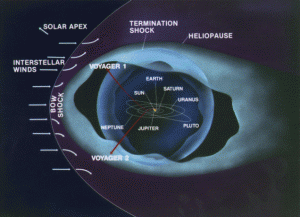Voyager 2 Skips a Beat
Flight directors at NASA’s Jet Propulsion Laboratory in California are troubleshooting a glitch with the distant Voyager 2 spacecraft, which is still sending back signals from the outer solar system 33 years after it was launched. According to a JPL release, ground controllers haven’t received inte…
Flight directors at NASA's Jet Propulsion Laboratory in California are troubleshooting a glitch with the distant Voyager 2 spacecraft, which is still sending back signals from the outer solar system 33 years after it was launched. According to a JPL release, ground controllers haven't received intelligible science data since late April; they suspect the craft's data formatting system.

Let's hope they're able to solve the problem. The twin Voyagers, which are speeding outward at better than nine miles a second, are our best chance to cross the "heliopause" where the solar wind yields to the charged particle "winds" of interstellar space. That could happen sometime in the next 10 years or so, which is about how long the nuclear batteries and thruster fuel are expected to last.

Let's hope they're able to solve the problem. The twin Voyagers, which are speeding outward at better than nine miles a second, are our best chance to cross the "heliopause" where the solar wind yields to the charged particle "winds" of interstellar space. That could happen sometime in the next 10 years or so, which is about how long the nuclear batteries and thruster fuel are expected to last.